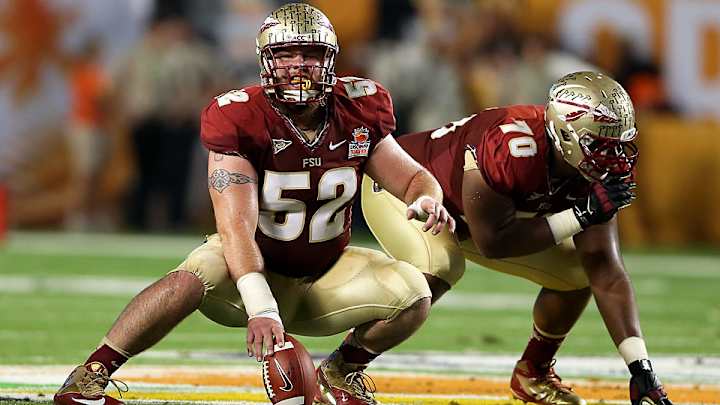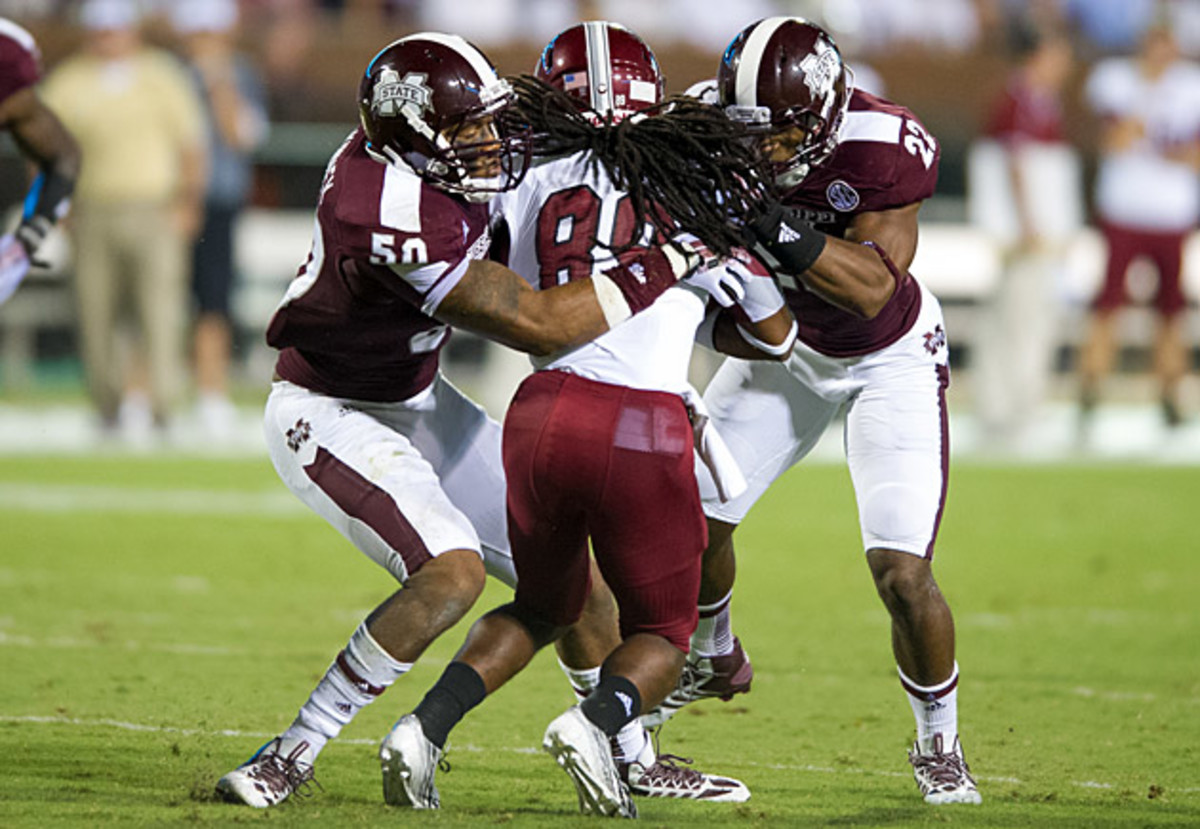Process of projection: How college coaches hit big on smaller recruits

When Dave Doeren took over NC State’s head coaching job in December 2012 following the firing of Tom O’Brien, athletic director Debbie Yow told Doeren that any player who committed to O’Brien’s staff was guaranteed a scholarship if he wanted it. Doeren fired up his computer to see the players he was about to sign. One highlight video immediately intrigued him.
The film belonged to Pharoah McKever, a 6-foot-6, 210-pounder from South Columbus High, a Class 2A school in Tabor City, N.C. “He was playing deep middle safety on defense, and he was just stroking people,” Doeren said. “And he was an option quarterback. You could tell he could run.”
McKever was committed to NC State as a receiver. After meeting with his future player, Doeren imagined a future in which McKever started each play with one hand on the ground. Doeren was playing a hunch that every college coach must master if he wants to remain employed.
A college coach who hits on about half of his recruits does pretty well. That may seem like a low expectation, but, in their evaluations, college football coaches must deal with the trickiest variable of all: puberty. Most males undergo radical physical changes between age 15, when they start getting recruited in earnest, and age 22, when they typically graduate from college. So, coaches must master the process of projection.
NFL teams have entire scouting staffs devoted to evaluating prospective players. They can ask potential draftees to undergo elaborate medical tests, which show everything from a player’s recovery from injuries to the density of his bones. They also have a distinct advantage, as everyone they evaluate is at least 20 years old.
College coaches aren’t so lucky. They can’t medically evaluate players, so they must rely on observation, experience, genealogy and old-fashioned intuition as they try to decide whether a 200-pound high school quarterback might someday grow into a 260-pound defensive end. Or whether a 240-pound high school tight end will leave for the NFL as a 300-pound center.
“Some guys are going to be 300 pounds if they work,” Florida State coach Jimbo Fisher said. “Other guys are going to be 300 pounds and it ain’t their choice. Them and God had a meeting, and they’re going to be 300 pounds.” Learning to differentiate between the two can separate a successful coach from a fired one.
Fourteen can't-miss college football recruits to watch in the 2014 season
Doeren’s idea for McKever needed time to incubate. Upon his arrival in Raleigh, McKever wanted to play wide receiver. Doeren said that would be fine. But, McKever told Doeren, if receiver didn’t work out he would play anywhere. Off with the receiving corps he went.
As McKever redshirted last fall, Doeren requested a small favor. The week leading into NC State’s game against Clemson on Sept. 10, Doeren asked if McKever would simulate Tigers speed rusher Vic Beasley. McKever did, and Doeren’s suspicions were confirmed. McKever had some natural proclivity for rushing the passer. Yet, he returned to receiver after the game.
Following the season, Doeren broached the idea of a position flip. McKever wanted one more shot at wideout. However, a day into spring practice, coach and player agreed to make the switch. “After two practices [at defensive end], everybody was in love with the guy,” Doeren said. McKever now weighs 256 pounds, and Doeren believes he’ll eventually grow past 270.
ELLIS: 2014 schedule guide: Which games will determine the playoff race?
McKever might wind up following in the footsteps of Jamie Collins, who was selected by the New England Patriots in the second round of the 2013 NFL draft. Collins was another lanky high school quarterback who went to college, bulked up and began terrorizing opposing passers. Current North Carolina coach Larry Fedora had just accepted Southern Miss’ top job in ‘08 when he came across the 6-3, 198-pound Collins playing quarterback and safety for Franklin County High in Meadville, Miss. Collins, who lost his parents when he was 6, was being raised by older sister Lisa Adams. Fedora had previously helped recruit high school tailback-turned-NFL defensive tackle Joe Cohen to Florida, and he remembers peppering Adams with genealogical questions. Collins had hands and wrists that looked too big for his body. Fedora sensed future growth.
“How big do you think he’s going to be?” Fedora asked Adams. Adams explained that Collins had some heavy branches in his family tree. “Oh, coach,” Fedora remembers Adams saying, “he’ll weigh 240, 250.” The Patriots currently list Collins at 250, so Adams and Fedora made a perfect projection.

Where does a coach start when projecting? The simplest question, coaches said, is to ask a player’s birthdate. This may sound rudimentary, but it makes a huge difference. A player slated to graduate high school at 17 should be evaluated differently than one who will graduate closer to his 19th birthday. The younger prospect is much more likely to add size and strength. The older one may pop off a YouTube clip and excite recruitniks, but may also be closer to his physical ceiling.
(Also, if it seems like a lot of these players are originally quarterbacks or safeties, that is because high school coaches tend to put their best athletes in positions where they can have the greatest impact. Depending on the offense, that means quarterback or tailback. On defense, it usually means free safety for two reasons. The star’s speed will allow him to reach most plays, and he is less likely to get injured because he isn’t taking on blocks every play.)
Florida coach Will Muschamp likes another basic question. He’ll ask recruits’ parents: “Is he shaving?” A 16-year-old who shaves daily is probably close to his final adult size. Meanwhile, a 260-pound lineman without enough peach fuzz to justify a razor is likely headed past 300 pounds, and might grow a little taller, too.
DEITSCH: College football TV roundtable: Sizing up 2014's big topics
Length is important. Tall, thin skill players in high school can grow into tall, thick players in college, depending on their frames. That’s why coaches will also check hand and joint size. For example, in an interview with Rivals.com, Florida State assistant coach Rick Trickett described a 260-pound tight end in the recruiting class of 2009 like this: “I really, really liked what I saw from this kid. He’s got huge hands, big feet, a tough guy.”
The prospect was Bryan Stork, a center who helped lead the Seminoles to the 2013 national title and who is now a 315-pound rookie for the Patriots. So, recruits shouldn’t be offended when a college coach’s handshake lingers. He is probably trying to see if a player’s wrist size offers any clue as to how many pounds he’ll pack on in college. Coaches will also ask family members and high school coaches about a player’s diet. Sadly, many can’t afford regular meals. College coaches must take into account how three steady meals could affect a player’s physique.
The Andy Staples Podcast: Larry Fedora talks North Carolina football
Meanwhile, two coaching staffs might look at the same player and see completely different futures. After Collins blossomed at Southern Miss, Mississippi State coach Dan Mullen asked his assistants why they didn’t make a run at the prospect in the 2009 recruiting cycle. The answer? Mullen and staff arrived between December ‘08 and January ‘09. They lacked the time to do the same homework as Fedora’s staff, which arrived in the state a year earlier. However, once Mullen and his staff settled in, they also began to find Miracle-Gro gems.
Mullen and his staff first saw Benardrick McKinney as a 6-3, 205-pound quarterback for Rosa Fort High in Tunica, Miss. McKinney came to Mississippi State’s camp the summer before his senior season, and Bulldogs coaches put him through linebacker drills. “He has size potential,” Mullen remembered thinking. “He has growth potential.” McKinney also had long limbs and seemed to enjoy contact. “When you combine all those things together,” Mullen said, “you have a freshman All-American linebacker.”
McKinney redshirted in 2011 and then exploded in ‘12 by racking up 102 tackles, including 4.5 for loss. Entering this season, McKinney is 6-5, 249 pounds, and he made FoxSports.com writer Bruce Feldman’s annual “Freaks” list by virtue of his 4.5-second 40-yard dash and his 34-inch vertical jump.
Still, what if a player insists he’s a quarterback or safety or tailback and can’t handle the idea of moving to a beefier position? TCU coach Gary Patterson, who helped transform Jerry Hughes from a high school tailback into a first-round NFL draft pick at defensive end, said that such resistance is rare once players start taking playing time and potential future earnings into account. “When it’s all said and done, they want to be at the position they can play at the highest level,” Patterson told reporters while reviewing his 2012 signing class. “It’s a very small percentage where a kid says, ‘I just don’t want to move. I just don’t want to do that.’ And usually, if they’re like that, what you’ll find out is it won’t matter. They can stay at that position, and they won’t achieve what they need to achieve. They won’t be as good as they think they are.”
The college coach who can accurately predict which high school quarterbacks, tailbacks and safeties will make the best linebackers, defensive ends and defensive tackles probably won’t have a problem convincing players to switch positions. They’ll trust him, because he’s probably winning. At the same time, he’s making the game even more challenging for opponents. “Let’s get the taller safeties, and let’s grow them into linebackers,” North Carolina’s Fedora said. “Let’s get the taller linebackers, and let’s grow them into D-ends. So, now, they’re all more athletic.”
